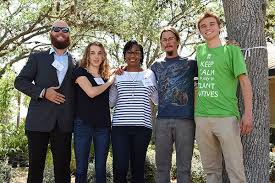Natalie Henly of Dunedin speaks with Michael Kuras, Craig Wilson and Witney Marsh about Sustainable Florida Native Landscaping.
This is Natalie Henley sustainability program coordinator here with Amanda Norton and Michael Kuras today. We’re here with the Dunedin Green Scene to discuss their transition from about 2,500 square feet of heavily irrigated lawn to a hundred percent native Florida plants. So, I just want to start off, thank you, Amanda for this transition. I know it was a, a big undertaking. What really initiated this process? Why did you want to transition to native plants?
Amanda Norton:
Well, I purchased the home in October and it just had zero curb appeal and I wanted to go with something that was more environmentally friendly and easily maintainable, but a look that gave my house curb appeal.
As the landscape designer, what are the benefits of having native Florida plants in a part of your landscape?
Michael Kuras:
Well, one of the major advantages is, these plants are adapted to this area, they’re natural to the area and consequently they require very little maintenance. They are not no maintenance, that’s a myth, but they are much lower maintenance. They attract a great number of pollinators, moths, butterflies, all sorts of other wonderful things, including hummingbirds for instance. In addition, they provide food for birds. Those are not just the local birds, but also migrating species, songbirds and so on. I’d say the ones that are very impactful, for instance, are the Beautyberry and the Firebush. They’re the ones that provide kind of the most visual impact you might say, and the sense that they are very proliferate in their flowering or for instance in their fruit production with the Beautyberry, the Firebush, as an example, has a bright orange-red flower you can see and it flowers the majority of the year.
Natalie Henley:
Also here today with us is Craig Wilson, the city’s arborist. And he’s going to share some of his thoughts on this project.
Craig Wilson:
So what’s important, I guess, first and foremost with this project is we did a substantial amount of removal of exotic invasive trees and plant species for that matter. And what that does is promote, native plants to return back, which further supports our ecosystem here, native birds, wildlife, and other insects that should be here. We now have the habitat that’s appropriate for it. So, another important feature that I like is that the plant selection is appropriate for this area. It’s drought-tolerant, so we won’t have to water the plants as much. But what’s often overlooked is the plant spacing. All too often we see plants planted too close together. Whereas with this project, you’ll notice some space in between the plants and that allows them to grow to full maturity.
So on this property, we have some newly planted Dahoon Hollys. You’ll see a nice row of them. There’s four here and they’re really great for birds and other wildlife. Take natural habitat and nesting. And then there’s also a, they produce the fruit are fruit that is very beneficial as well.
Michael Kuras:
Some of the things we did in order to reduce, the use of turf on this property is we covered it in the areas that work actually planted with pine straw or pine needles as they’re sometimes called. In addition, we used a shell which is collected locally at its wash to make sure there’s no excess ceiling content.
Natalie Henley:
I’m also here today with our stormwater program coordinator, Whitney Marsh.
Whitney Marsh:
Thank you, Natalie. So one of the things that helps when you have a Florida friendly yard with her stormwater is you end up having less nutrients that are applied down to your lawn. You have less fertilizers, which results in less phosphorous and nitrogen runoff that goes to our waterways. So what that does for us is it helps to reduce the loadings that go into our waterways that lead downstream into St Joseph Sound. And that also helps to prevent algae blooms that we can see here in the summertime months in Florida, especially the blue-green algae’s. That can be our toxic algae that have been found here in Dunedin.
Natalie Henley:
On behalf of the Dunedin Green Scene community spotlight with Amanda. We just want to say thank you to all of her work, Michael’s work, and everyone who came out today to really celebrate this transition to a native Florida landscape. If you want to learn more about Florida friendly landscaping, please contact myself. Go on our city website under Dunedin Green Scene or check out the UF/ IFAS extension as they have many great materials and resources for you. This is Natalie with Dunedin Green.

